Links to Treadwells in America...
This was a time of great social upheaval in England, including religious
persecution, and sometimes families travelled considerable distances to
settle in other parts of the country in search of a better life. It was
a time when some families even left the country in search of a new life
overseas, notably America.
Although it cannot yet be proven, it is quite likely that our Treadwell
ancestors are directly linked to the Treadwells who emigrated to America
from north Oxfordshire in the early 17th century. Their modern day ancestors
can claim connections with the actors Orson Welles (his great grandmother
was Mary Jane Treadwell born 1827) and Spencer Tracy (he was married to
Louisa Ten Broeck Treadwell born 1896). There is even a gold rush town
in Alaska called Treadwell named after John Treadwell, the owner of Alaska
Juneau Mining Company. John sold his interest in the Treadwell properties
in 1889 for a reported \$1,500,000 and returned to California, only subsequently
to be bankrupted in 1914 after a failed venture with his brother James
in a trust company.
Back to Top
Links to Treadwells in Australia and New
Zealand...
As well as America, the Oxfordshire Treadwells emigrated to Australia
and New Zealand in the mid-1800s, about 200 years later. This came to light
when researching our own line of the family in Kent. Until we are able
to confirm a direct link, as far as we know none of our branch of the Treadwell
family have settled in America. However, we do have several links to Australia
and New Zealand, notably by way of John Treadwell (born in Hartley in 1833)
and one of his nephews, John Cooper Treadwell (born in Hartley in 1868).
John Treadwell arrived in Melbourne in 1852 at the beginning
of the State of Victoria's "gold rush" period. Nine of ten children
from his marriage to New Zealander Ellen Dean were born in either Maldon
or Sandhurst close to the heart of the gold-mining area. Gold was first
discovered at Summer Creek in New South Wales in 1851 and by the next year,
when John arrived in Australia, further discoveries had led to a gold rush
that was centred on Mount Alexander, Ballarat and Sandhurst. Mount Alexander
is now known as Castlemaine. Sandhurst was founded on a sheep run in 1840
but changed its name to Bendigo in 1891, to honour a local prize-fighter
who compared his own prowess to that of the English pugilist known as Bendigo.
Gold mining ceased in Bendigo as recently as 1955.
In the ten-year period until 1861, Australia exported more than £124
million worth of gold alone (about £5 billion at today's prices)
and its population reached 1.2 million, a threefold increase over the 1850
population of 400,000. Immigrants to Australia's eastern colonies came
from Britain, America and Canada while from Asia a large number came from
China. John Treadwell was one of these early pioneers and he continued
to pursue his trade as a blacksmith supporting the gold-mining industry.
In 1851, just one year before his departure for Australia, John's
grandfather Francis died. Francis was yeoman farmer of Fairby Farm in
Hartley but on his death it is believed the Will was contested due to
the illegitimacy of his son William, John's father. William himself had
died in 1849 meaning that Francis' death would have placed his
grandchildren, including John, at the centre of legal proceedings over
their right to inherit the family estate.
It seems the outcome of the litigation did not favour John and his siblings.
According to the Reverend Bancks, the Treadwells' association with Fairby
ended "in the middle of the century" when the estate passed over
to a Mr. J.T. Smith of Eltham [for more information on the connection to Mr. J.T. Smith follow this link http://digilander.libero.it/DURHAM_FAMILY/DURHAM-SMITH.htm]. John's older brother William continued farming
in Hartley at New House Farm and another brother James farmed several years
before moving to Newington, London where he became a "car man".
One motivation for John's decision to find a new life in Australia may
have been the absence of a clear future in England, due to the loss of
the family inheritance.
Today, many of John's descendants are living in the Melbourne area.
However, he was not the first Treadwell to set foot on Australian soil.
For example, there is another branch of the Treadwell family, also living
around Melbourne, and descendents of a Thomas Treadwell of Dorchester,
Oxfordshire. This Thomas sailed to Australia in 1849, 3 years before John,
on the vessel "Tasman" together with his wife, Martha Hornblower,
and their first 2 children. Despite living in the same part of Australia,
our "Kent" branch of the family has until now had no social contact
with their namesakes descended from Thomas of Dorchester.
Apart from the coincidence of John Treadwell's wife coming from Wellington,
our family's link to New Zealand is, as mentioned above, through John's
nephew John Cooper Treadwell. John Cooper was the youngest
son of John's brother William. Here is an extract from the Family Bible
kept by John's parents William and Eliza Treadwell which shows he was born
at Hartley, together with his other brothers and sisters.

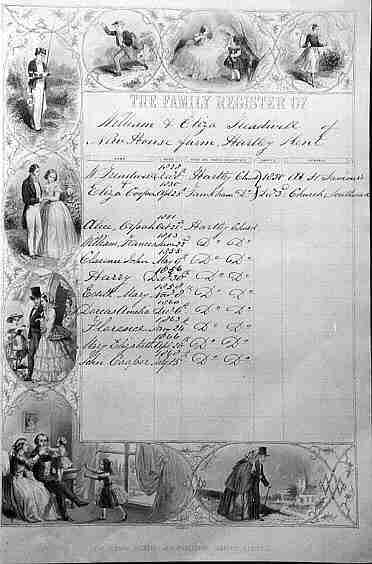
Maybe John Cooper Treadwell was influenced by his uncle's decision to
emigrate about 40 years earlier to Australia and possible stories about
the fortune to be made in the new "colonies"? Anyway, John arrived
in New Zealand in 1890 and he married Catherine Frances Conchie in 1900.
Their offspring are living today in and around Auckland in North Island
and are even as far afield as the Falkland Islands...
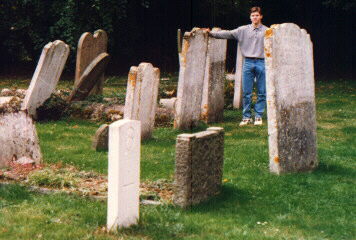 The "Treadwell Tombs", Hartley (and
my nephew Tony)
The "Treadwell Tombs", Hartley (and
my nephew Tony)
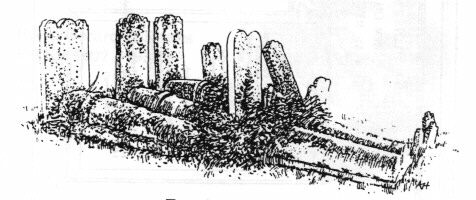 One of the headstones has an inscription in
memory of John Cooper Treadwell.
He died at Otaki, New Zealand, 5th November
1907
One of the headstones has an inscription in
memory of John Cooper Treadwell.
He died at Otaki, New Zealand, 5th November
1907
Back to Top
Remaining Challenges
The task of linking our Kent line of the Treadwell family to the Oxfordshire
Treadwells, both those who emigrated to America and those living today
in Australia and New Zealand, is one of the major remaining challenges.
From our own family origins, we know already that any connection between
these various branches of the family must have been before 1700. There
are significant difficulties in obtaining data for this period, apart from
the fact that the events happened more than 300 years ago!
It is also a challenge to try to understand better how many individual
branches of Treadwell there are in Australia and New Zealand, partly as
a means of identifying more accurately those which belong to our own Kent
line. For example, I have already identified at least 3 distinct Treadwell
branches in Australia, and I am aware of at least 2 Tre(a)dwell branches
in New Zealand, none of which have any direct relation to our own family.
Back to Top
The Village of Hartley
Time and time again the village of Hartley features as the birthplace
of many of my ancestors. Hartley is at the centre of a wider area of northwest
Kent where most of our branch of the family have lived and still live.
My family were local yeoman farmers and several generations were publicans
of the Black Lion public house in the village.
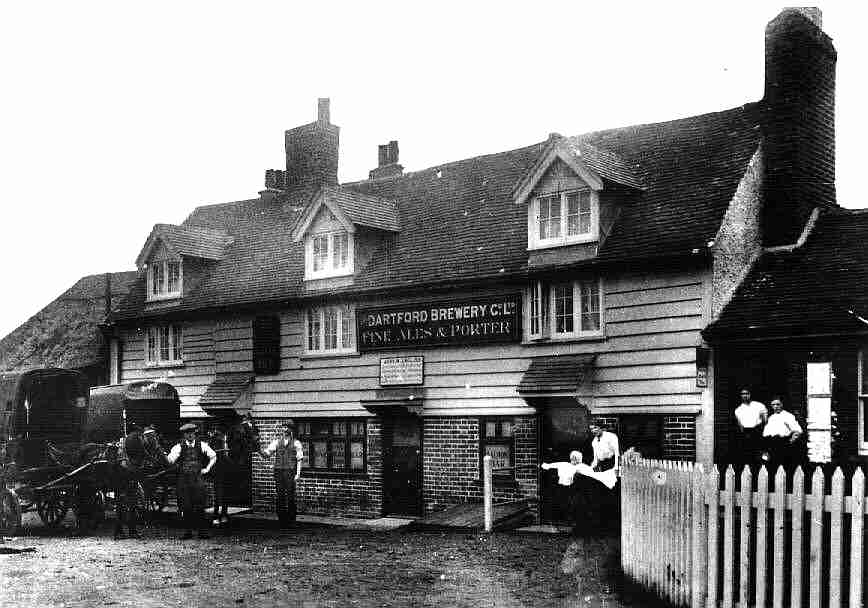
In 1998, an extension was made to the building to create a new restaurant
called "Defoe's". The restaurant was named after Daniel Defoe,
the author of the well known book "Robinson Crusoe", who is believed
to have lived in a small cottage in part of the building which is today
the "Black Lion".
During the construction works, a bottle was found in the walls of the
old building which was placed there in the mid-1800s by Henry Cooper, the
son of William Cooper and Amelia Treadwell. The bottle contained a note
written on 23 May 1861 which provides an insight into life in Hartley at
that time.....
"This building was erected by Henry son of Wm and Amelia Cooper
of the White House, Fawkham in the 27th year of his age in the year of
our Lord 1861. He laid every stone himself and never learnt the trade.
He mixt his own mortar and done all that was required to the building.
The premises belonged to Charles and William Fleet at Dartford and was
in the occupation (sic) of Rhoda Treadwell Aunt to H Cooper. H Cooper collected
the flints from all parts. Some from the Church which was then under repair.
Some from the bottom of the railroad (then under construction). Some from
the ruins of the old chapel in Chapel Wood. The farms in the parish was
then occupied by the following persons Hartley Wood (now called Hartley
Manor) by Wm Benstead, Hartley Court by Wm Allen, New House (demolished
and the site now part of New Ash Green) by Wm Treadwell, Fairby by James
Thomas Smith Deptford, Middle Farm (now occupied by Alan McCann, the finder
of this document) by George Best, the Revd Edward Allen Rector Wm Witton
Allen Curate at the Rectory House (near the station and demolished). This
will give some idea of how things was breaking in 1861. Victoria Queen
and Albert".
Henry later became publican of the Black Lion Inn at Hartley and was
recorded as such in the 1871 Census. He took over from his aunt Rhoda Treadwell
and, before her, his grandfather William Treadwell.
The Rev. C.G.W. Bancks, author of "Hartley Through the Ages",
referred to the origins of the name Hartley in the Parish Magazine (October
1924). It seems, in olden days, Hartley was known by many different forms
of spelling: Heortlea, Heorut-lea, Herets-ley, Herteleigh, Hertlegh, Herdei,
Erclei, Haesel-holt, and finally Harteleye and Hartley. The first part
of the word may be derived from the Saxon Heorot. Leah or lea meant pasture
land. So, Heortlea might mean the lea or meadow of the hart (a small deer).
But there is another possible derivation. The Danes and the Wends have
left many traces of their occupancy in the place names of northwest Kent,
for example, Sweynscamp (Swanscombe), Herotfelda (Harvel), and Stanihtan-dyrst
(Stansted). Heorotha was a Wendish female deity, so Heortlea may have indicated
a verdant clearing in the forest sacred to this goddess.
 Domesday Book Entry for ‘Erclei’ 1086
Domesday Book Entry for ‘Erclei’ 1086
Hartley is recorded in the Domesday Book as Erclei, which was the Norman
version of the Saxon Heortley.
Back to Top
The Family Estate of Fairby
The village of Hartley has certainly featured prominently in our family's
history since at least the early 1700s. However, within Hartley Parish,
the estate of Fairby has also played a major role and may be regarded as
the family's spiritual or even metaphysical home if local
folklore is to be believed! Fairby takes its name from "John Feerby
of Hertle" whose family Fer(e)by lived at Speldhurst in the 14th Century
but eventually moved to St. Paul's Cray near Orpington.
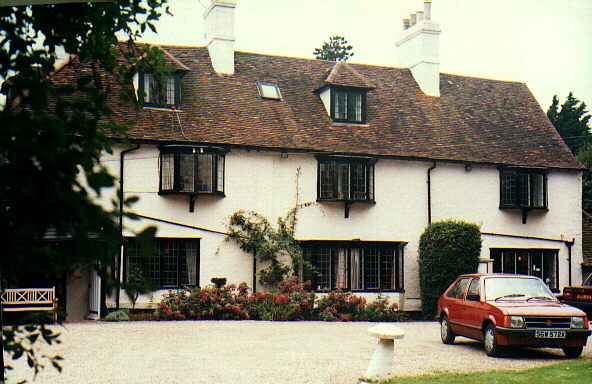
Fairby House as it looks today. It is now called Fairby Grange, an old-people's
home. In former times the servants used to live upstairs in this house,
not downstairs! There are large rooms with inglenook fireplaces at the
front downstairs. John Treadwell who emigrated to Australia in 1852 was
born in a room in the attic in 1833.....
Back to Top
The Village of Southfleet,
Westwood and Betsham
Just a few miles north of Hartley in the direction of Gravesend lies
the village of Southfleet and its smaller communities Betsham and Westwood.
Many of my ancestors have lived in these settlements. Several of them were
farmers and one of them, William Treadwell, was publican of the Harrow
at Betsham. William was landlord of the "pub" in the 19th Century
and here is a liquor licence granted by the local magistrates in 1824.
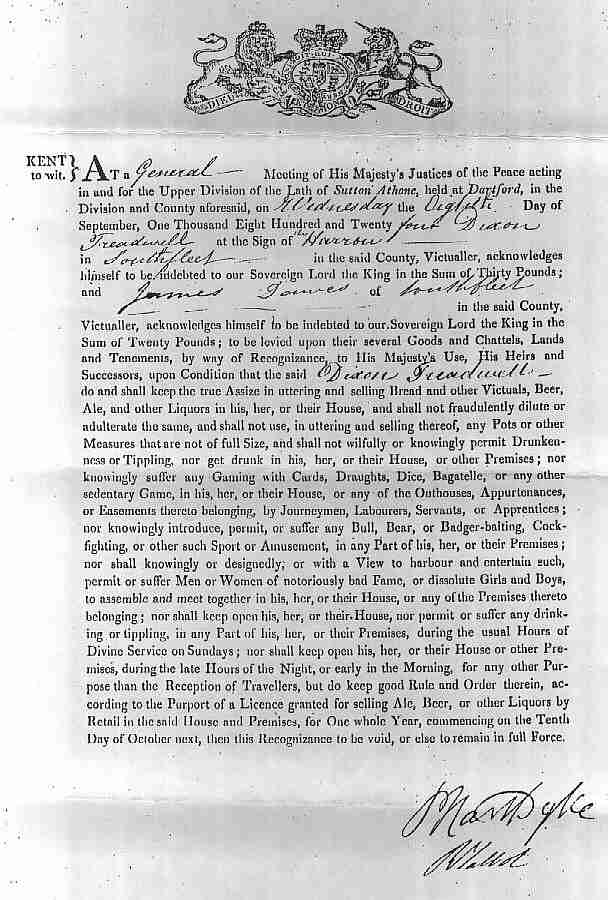
The "Harrow" was renamed "The Colyer Arms" after
World War I in honour of the son of the locally influential Colyer-Ferguson
family who was killed during the War.
My grandmother, Jessie Treadwell (née Appleby) was an accomplished
pianist and used to provide the musical accompaniment for large family
gatherings at the home of my great-grandparents George "Tubby"
Treadwell and Fanny Mary Treadwell (née Hills). The old thatched
cottage in which they lived for many years is still there and looks very
much the same today as it did in this old photograph. Just a short distance
away from Westwood there is an old railway line that once used to carry
Queen Victoria to the Isle of Grain where she would board a ship to the
Continent to visit her German "cousins". That same railway line,
which was closed in the 1960s as part of the "Beaching cuts",
is now being upgraded and redeveloped imaginatively as part of the link
to the high-speed railway line between London, Paris and Brussels.
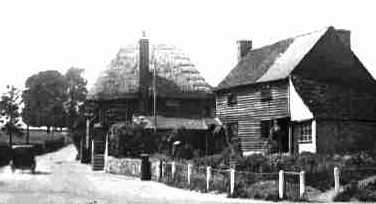
My grandparents cottage is on the right of the photograph and has a
well in the front garden. Part of the cottage also functioned as a small
shop so that local people would not always need to travel to Longfield
or Gravesend. In the centre background is a larger thatched building which
is now the Wheatsheaf public house.
Back to Top
Our Headless Horseman!
According to an article in a local newspaper from 1974, it appears we
have a headless horseman in the family: -
A LIGHT-HEARTED LOOK AT HARTLEY
Just how do you identify a headless horseman?
HAVE YOU ever wondered how a headless horseman sees where
he is going?
Come to that, how can anyone identify such a faceless
phantom?
If questions like those keep you awake at night, you can
always pop over to the village of Hartley and ask for they have a headless
horseman all their own.
Perhaps I should say "had". For as far as I
can tell, he has not been seen for a while and is distinctly camera-shy.
Despite these problems, local people seem to be in no doubt as to whom
he is.
The rider who has no trouble with collar-sizes is said
to be none other than Richard Treadwell, a well-known late 18th-century
resident, who still has relatives in the area.
Quite why he rides around his old house, "Fairby",
is less clear. Ghosts generally seem to revisit a place if they have lost
something there, or so they say. Very often the something that they lost
was their life.
Not so in this case, though the house of Fairby was one
of considerable importance to Treadwell. His family had lived in Hartley
as yeoman farmers for hundreds of years.
Fairby, effectively the great house of the village, was
probably originally built by a family of landowners called Feerby or Ferby
back in the 15th century. But in Richard Treadwell's time it was in the
hands of another wealthy family, the Youngs, who had rebuilt it in 1612.
It was to be Richard Treadwells's destiny to inherit the
house, for he married the last heir of the Young family, Mary, in 1743.
The couple met in dramatic circumstances. Early in the
18th century the House was burgled. The raiders gagged and bound the master
and his wife but little Mary Young, then only five, slipped out and summoned
the Treadwells to help. The thieves were driven off and the Youngs freed
unhurt.
So far so good. It reads like one of those half-hour historical
series that the BBC tends to screen at about 4.30 on Sunday afternoon.
Richard married Mary and inherited the house, catapulting himself several
rungs up the social scale in the process.
Unfortunately, the thieves in their flight found they
could not carry off the family plate and perhaps intending to return for
it, they threw it down the 300-foot well which is under the present kitchen.
Treadwell's repeated efforts to retrieve the treasure
all met with failure, and as far as anyone knows, the gold and silver plate
is still there.
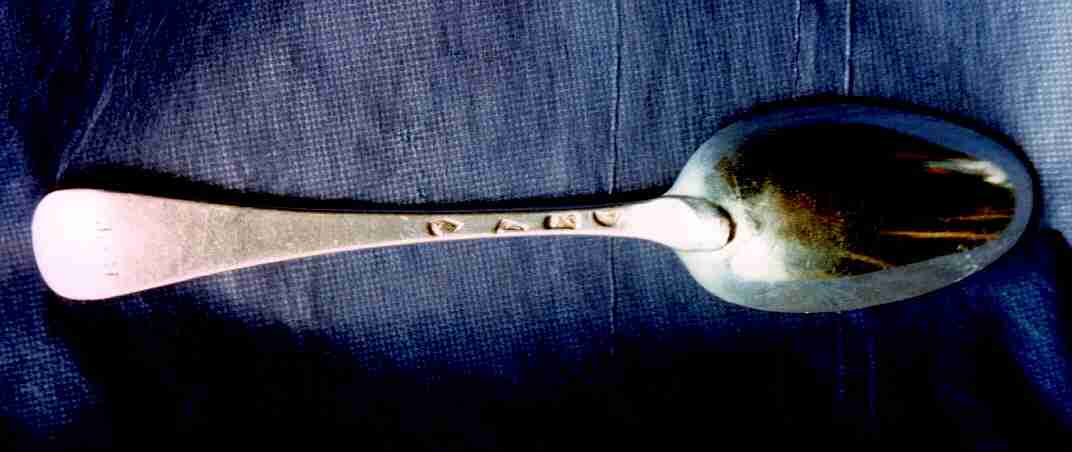 Part of the silver still
exists and has been passed down the generations to relatives in New Zealand
This silver spoon has Richard
Treadwell's monogram on it
So maybe this is what the headless Richard has returned
for though how he came to lose his head must remain a mystery. His body
(as far as we know intact) lies beside his wife under the aisle of Hartley
Parish Church.
Part of the silver still
exists and has been passed down the generations to relatives in New Zealand
This silver spoon has Richard
Treadwell's monogram on it
So maybe this is what the headless Richard has returned
for though how he came to lose his head must remain a mystery. His body
(as far as we know intact) lies beside his wife under the aisle of Hartley
Parish Church.
Back to Top

 Home Page
Home Page